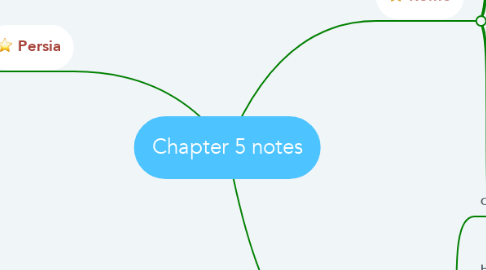
1. Persia
1.1. Culture
1.1.1. Advanced iron technology Zoroastrianism emphasized the importance of personal moral artistic lifestyle Conquered by Alexander the Great Persian language and culture survived into the 20th century Persian art effected the region as well as India and the wider middle east.
1.2. Human-Environment
1.2.1. At its height the Persian empire stretched through much of the Middle East to the shores of the Mediterranean, into Egypt, and into the northwest part of the Indian subcontinent.
1.3. Economic Factors
1.3.1. The Persian Empire obtained much of its wealth as a result of its prolific crops. Even some of the most urban cities in the empire relied on agriculture. Barley was the main cereal staple of Persian agriculture, being easily grown in most areas of the empire. However, there were a great many other crops grown throughout differing regions. Wine production also became one of Persia's more common commodities. Government programs worked towards expanding agricultural production in the empire. Government money was invested in improving irrigation, the quality of the crops, and the latest farming techniques.
1.4. Political Structures
1.4.1. Cyrus the Great founded massive Persian empire. Successor to Mesopotamian states in the past. Tolerant of different languages and cultures.
1.5. Social Structures
1.5.1. People followed Zoroastrianism
2. Greece
2.1. Culture
2.1.1. The Greek city-states also joined in regular celebrations such as the athletic competitions of the Olympic Games. Hellenistic was the culture associated with the spread of Greek influence as a result of Macedonian conquests; often seen as the combination of Greek culture with eastern political forms.
2.2. Human-Environment
2.2.1. Athens is located north of the Mediterranean sea and east of modern day Italy.
2.3. Economic Factors
2.4. Political Structures
2.4.1. In 5th-century Athens, the major decisions of state were made by general assemblies in which all citizens could participate. This was a direct democracy
2.5. Social Structures
2.5.1. citizens – slave/foreigners – women excluded > 25% participate. The lower class wanted more power so they recommended stupid military choices.
3. Rome
3.1. Culture
3.1.1. Christianity spread, but not a product of Christian/Roman Culture
3.2. Human-Environment
3.2.1. Farming was difficult due to the hilly environment
3.3. Economic Factors
3.3.1. Much tension comes from farmers trying to keep independence and get out of debt Forced olives, grapes – but these need capital, patience – 5 years – landlord Commercial agriculture led to need for empire Supervised grain trade, public works, storage facilities Manufactured products less advanced – exported animals/skins, metals Merchants – better in Mediterranean than China, but ambiguous Slavery was a key component-agriculture – from military expansion Free farmers couldn’t compete with slave/tenant labor Hurt technological innovation – behind India/China in production technology
3.4. Political Structures
3.4.1. Constitution – relied on aristocracy – election of magistrates Senate – held executive offices – two consuls shared power – public speaking Strong military organization Well-crafted laws – Twelve Tables 450 BCE – restrain upper class Rules, not personal who, should govern people regulated property, commerce similar to Chinese bureaucratic structure
3.5. Social Structures
3.5.1. Tight Family Structure, women were inferior to men.

